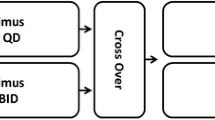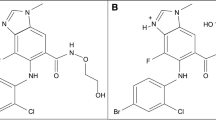Abstract
Rapamycin-28-N,N-dimethylglycinate methanesulfonate salt (RG), synthesized as a potential water-soluble prodrug to facilitate parenteral administration of the antineoplastic macrolide rapamycin (RA), is active against intracranially implanted human glioma in mice. Preclinical pharmacokinetic studies to evaluate the prodrug were conducted in male CD2F1 mice treated with 10, 25, 50 and 100 mg/kg doses of RG by rapid i.v. injection. The plasma concentration of RG decayed in a distinctly triphasic manner following treatment with the 100 mg/kg dose; however, prodrug disposition was apparent biexponential at each of the lower doses. RG exhibited dose-dependent pharmacokinetics, characterized by an increase in the total plasma clearance from 12.5 to 39.3 ml·min−1·kg−1 for dosage escalations in the range 10–50 mg/kg, while clearance values at doses of 50 and 100 mg/kg were similar. The terminal rate constants decreased linearly as the dose was increased from 10 to 100 mg/kg, eliciting an apparent prolongation of the biological half-life from 2.1 to 4.8 h. There was also a sequential increase in the steady state apparent volume of distribution from 1.73 to 8.75 l/kg. These observations are consistent with saturable binding of RG to plasma proteins while binding to tissue remains linear. Nevertheless, conversion to RA appeared to represent a prominent route of RG elimination. The molar plasma concentration of RA exceeded that of the prodrug within 30–90 min after i.v. treatment and declined very slowly thereafter, with plasma levels sustained between 0.1 and 10 μm for 48 h at each of the doses evaluated. Thus, RG effectively served as a slow release delivery system for RA, implying the possibility of maintaining therapeutic plasma levels of the drug from a more convenient dosing, regimen than a continuous infusion schedule. The present findings, coupled with the demonstrated in vivo activity of RG against human brain tumor models, warrant its continued development as a much needed chemotherapeutic agent for the treatment of brain neoplasms.
Similar content being viewed by others
Abbreviations
- AUC:
-
area under plasma concentration-time curve between time zero and infinity
- CL:
-
total plasma clearance
- Az:
-
terminal phase elimination rate constant
- MRT:
-
mean residence time
- t1/2,z :
-
half-life of terminal disposition phase
- Vz :
-
total body apparent volume of distribution
- V1 :
-
central compartment apparent volume of distribution
- Vss :
-
apparent volume of distribution at steady state
References
Vezina C, Kudelski A, Sehgal SN (1975) Rapamycin (AY-22,989), a new antifungal antibiotic. I. Taxonomy of the producing streptomycete and isolation of the active principle. J Antibiot (Tokyo) 28:721
Sehgal SN, Baker H, Vezina C (1975) Rapamycin (AY-22,989), a new antifungal antibiotic. II. Fermentation, isolation and characterization. J Antibiot (Tokyo) 28:727
Findlay JA, Radics L (1980) On the chemistry and high field nuclear magnetic resonance spectroscopy of rapamycin. Can J Chem 58:579
Swindells DC, White PS, Findlay JA (1978) The x-ray crystal structure of rapamycin, C51H79NO13. Can J Chem 58:2491
Martel RR, Klicius J, Galet S (1977) Inhibition of the immune response by rapamycin, a new antifungal antibiotic. Can J Physiol Pharmacol 55:48
Morris RE, Meiser BM (1989) Identification of a new pharmacologic action of an old compound. Med Sci Res 17:609
Chang JY, Sehgal SN (1991) Pharmacology of rapamycin: a new immunosuppressive agent. Br J Rheumatol 2:62
Chang JY, Sehgal SN, Bansbach CC (1991) FK-506 and rapamycin: novel pharmacological probes of the immune response. Trends Pharmacol Sci 12:218
Singh K, Sun S, Vezina C (1979) Rapamycin (AY-22,989), a new antifungal antibiotic. IV. Mechanism of action. J Antibiot (Tokyo) 32:630
Aszalos A, Robinson RS, Lemanski P, Berk B (1968). Trienine, an antitumor triene antibiotic. J Antibiot (Tokyo) 21:611
Douros J, Suffness M (1981) New natural products under development at the National Cancer Institute. Recent Results Cancer Res 76:153
Douros J, Suffness M (1981) New antitumor substances of natural origin. Cancer Treat Rev 8:63
Eng CP, Sehgal SN, Vezina C (1984) Activity of rapamycin (AY-22,989) against transplanted tumors. J Antibiot (Tokyo) 37:1231
Broome MG, Johnson RK, Silveira DM, Wodinksy I (1983) Biochemical and biological effects of the two unique antitumor antibiotics: rapamycin (NSC 226080) and macbecin II (NSC 330500) (abstract). Proc Am Assoc Cancer Res 24:1271
Houchens DP, Overjera AA, Riblet SM, Slagel DE (1983) Human brain tumor xenografts in nude mice as a chemotherapy model. Eur J Cancer Clin Oncol 19:799
Baker H, Sidorowicz A, Sehgal SN, Vezina C (1978) Rapamycin (AY-22,989), a new antifungal antibiotic. III. In vitro and in vivo evaluation. J Antibiot (Tokyo) 31:539
Sehgal SN, Baker HH, Sidorowicz AM, Vezina C (1981) Injectable composition of rapamycin (abstract). Chem Abs 96:129797b
Deskin R, Pydlek D, Grumbein S, Greenspun K, Kastello M (1983) Preclinical single and five daily dose range-finding lethality and toxicity studies in Sprague-Dawley rats, and toxicity studies in beagle dogs administered rapamycin (NSC-226080) (abstract) Chem Abs 99:205773v
Stella VJ, Kennedy PE (1987) Water-soluble rapamycin prodrugs. US Pat No 4,650,803
Gibaldi M, Perrier D (1982) Pharmacokineties, 2nd edn., Dekker, New York, p 409
Rowland M, Tucker G (1980) Symbols in pharmacokinetics. J Pharmacokinet Biopharm 8:497
Benet LZ (1972) General treatment of linear mammillary models with elimination from any compartment as used in pharmacokinetics. J Pharm Sci 61:536
Lam I-C, Hung CT, Perrier DG (1985) Estimation of variance for harmonic mean half-lives. J Pharm Sci 74:229
Bundgaard H (1985) Design of prodrugs. Elsevier Science, New York, p 1, 135, 259
Author information
Authors and Affiliations
Rights and permissions
About this article
Cite this article
Supko, J.G., Malspeis, L. Dose-dependent pharmacokinetics of rapamycin-28-N,N-dimethylglycinate in the mouse. Cancer Chemother. Pharmacol. 33, 325–330 (1994). https://doi.org/10.1007/BF00685908
Received:
Accepted:
Issue Date:
DOI: https://doi.org/10.1007/BF00685908




